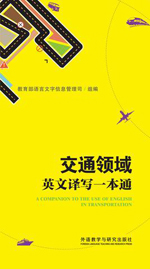Navigating the Cross
孙博文爱中国
English Translations in the Transportation Sector emerges as a vital and
comprehensive guide that bridges the linguistic and technical gaps
within the global transportation industry. This meticulously curated
book, tailored for professionals, academics, and enthusiasts, offers a
deep - dive into the intricacies of translating transportation - related
content, from technical manuals and policy documents to public
announcements and safety guidelines. One of the book's most
significant strengths is its broad scope of coverage. It encompasses
various modes of transportation, including road, rail, air, and
maritime. For instance, it provides detailed analyses of how to
accurately translate terms related to traffic engineering, such as
"intersection control," "traffic flow optimization,"
and "road surface texture," ensuring that technical precision
is maintained across languages. In the aviation section, readers learn
about translating complex aeronautical terminologies, like "flight
procedures," "aircraft maintenance schedules," and
"aviation regulations," which are crucial for international
safety and operational coherence. The book's practical approach sets
it apart. It is filled with real - world examples, case studies, and
practical tips that equip translators with the necessary skills to
handle transportation - specific translations effectively. For example,
it showcases how cultural nuances can impact the translation of
transportation - related public service announcements. A safety message
that is straightforward in one language might require a different tone
and approach in another to ensure it resonates with the target audience.
By presenting these scenarios, the book helps translators anticipate and
overcome potential challenges. Moreover, English Translations in the
Transportation Sector addresses the evolving nature of the industry. It
delves into emerging areas such as intelligent transportation systems
(ITS), electric vehicle infrastructure, and sustainable mobility.
Translators are guided on how to handle the translation of new - age
terminologies like "autonomous driving algorithms,"
"electric vehicle charging stations," and "green
transportation policies." This forward - thinking perspective
ensures that the book remains relevant in an increasingly digital and
environmentally - conscious transportation landscape. The book is also
well - structured, with clear sections dedicated to different types of
translations and language pairs. This organization makes it easy for
readers to find relevant information quickly. The inclusion of
glossaries of key transportation terms in multiple languages further
enhances its practical utility, serving as a handy reference for on -
the - spot translations. However, one potential limitation is that the
book could benefit from more in - depth discussions on the use of
translation technology in the transportation sector. With the rise of
machine translation and translation management systems, a more
comprehensive exploration of how these tools can be optimized for
transportation - related translations would be valuable. Overall,
English Translations in the Transportation Sector is an indispensable
resource for anyone involved in translating content within the
transportation domain. It not only imparts essential knowledge and
skills but also highlights the critical role that accurate translation
plays in ensuring global transportation safety, efficiency, and
interoperability. Whether you are a seasoned translator looking to
specialize in transportation or a novice aiming to understand the field,
this book is a reliable compass to guide you through the complex world
of transportation translations.



 京公网安备 11010802032529号
京公网安备 11010802032529号